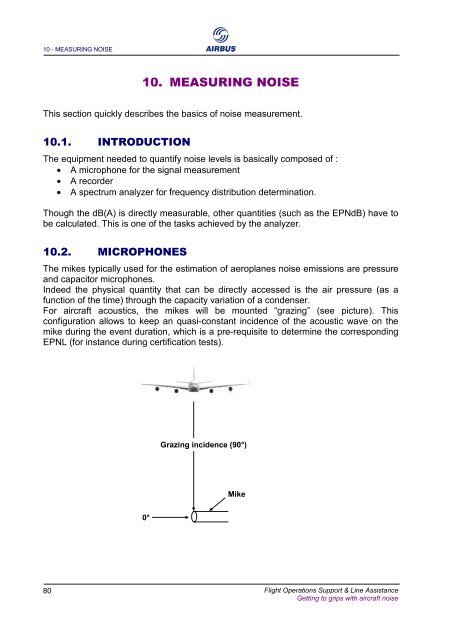Getting to Grips with Aircraft Noise
Getting to Grips with Aircraft Noise
Getting to Grips with Aircraft Noise
You also want an ePaper? Increase the reach of your titles
YUMPU automatically turns print PDFs into web optimized ePapers that Google loves.
10 - MEASURING NOISE<br />
80<br />
10. MEASURING NOISE<br />
This section quickly describes the basics of noise measurement.<br />
10.1. INTRODUCTION<br />
The equipment needed <strong>to</strong> quantify noise levels is basically composed of :<br />
• A microphone for the signal measurement<br />
• A recorder<br />
• A spectrum analyzer for frequency distribution determination.<br />
Though the dB(A) is directly measurable, other quantities (such as the EPNdB) have <strong>to</strong><br />
be calculated. This is one of the tasks achieved by the analyzer.<br />
10.2. MICROPHONES<br />
The mikes typically used for the estimation of aeroplanes noise emissions are pressure<br />
and capaci<strong>to</strong>r microphones.<br />
Indeed the physical quantity that can be directly accessed is the air pressure (as a<br />
function of the time) through the capacity variation of a condenser.<br />
For aircraft acoustics, the mikes will be mounted “grazing” (see picture). This<br />
configuration allows <strong>to</strong> keep an quasi-constant incidence of the acoustic wave on the<br />
mike during the event duration, which is a pre-requisite <strong>to</strong> determine the corresponding<br />
EPNL (for instance during certification tests).<br />
0°<br />
Grazing incidence (90°)<br />
Mike<br />
Flight Operations Support & Line Assistance<br />
<strong>Getting</strong> <strong>to</strong> grips <strong>with</strong> aircraft noise


